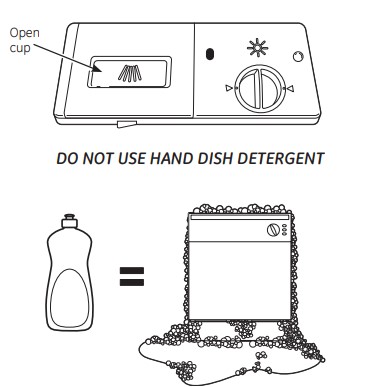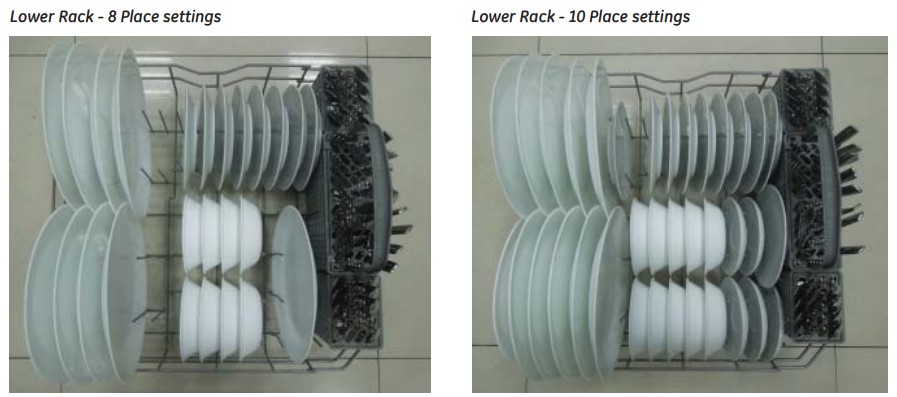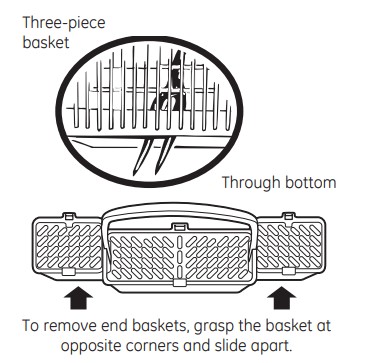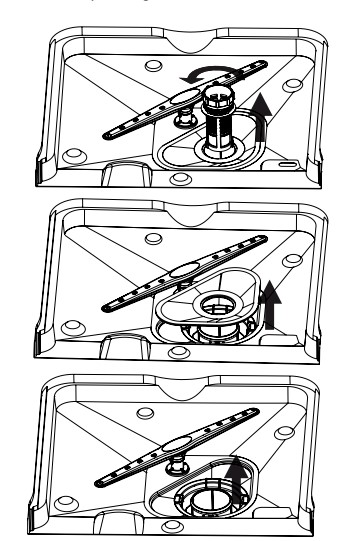Documents: Go to download!
- Owner's manual - (English, French, Spanish)
- Operating Instructions
- Care and Cleaning
- TROUBLESHOOTING
Table of contents
Owner’s Manual Dishwasher
Operating Instructions
Getting started
Features and appearance will vary throughout this manual

1. Load Dishwasher: For best dishwashing results, follow the loading guidelines found in the Loading the dishwasher section. No pre-rinsing of normal food soil is required. Scrape off hard soils, including bones, toothpicks, skins, and seeds. Remove leafy vegetables, meat trimmings, and excessive amounts of grease or oil
2. Add Detergent: Add needed amount of detergent to the detergent dispenser. Use a detergent such as Cascade® Platinum Pacs. See Detergent Dispenser in the Using the dishwasher section
3. Add Rinse Agent: Add Rinse Agent to the rinse agent dispenser. See Use a Rinse Agent in the Using the dishwasher section.
4. Select Cycle
- Open the door and press the Select button for the desired wash cycle. The LED above the cycle name will be lit to indicate which wash cycle has been selected. Press the button until the desired cycle is shown.
- NOTE: All cycle times and water usage information contained in this section are approximate values. Actual results will depend on several factors including, but not limited to, inlet water temperature and household water pressure.
| Sanitize |
4.8 gallons, 130 minutes This cycle raises the water temperature in the final rinse to sanitize your dishware. The cycle length may vary depending on the temperature of your inlet water. NOTE: This cycle is monitored for sanitization requirements. If the cycle is interrupted during or after the main wash portion or if the incoming water temperature is so low that adequate water heating cannot be achieved, the sanitizing conditions may not be met. In these cases, the Sanitized light will not illuminate at the end of the cycle. Utilizing this option will modify the cycle to meet the requirements of Section 6, NSF 184 for soil removal and sanitization efficacy. NOTE: NSF certified residential dishwashers are not intended for licensed food establishments. |
| Heavy |
6.7 gallons, 125 minutes This cycle is meant for heavily soiled dishes or cookware with dried-on or baked-on soils. This cycle may not remove burned-on foods. Everyday dishes are safe to be used in this cycle |
| Normal |
3.8 gallons, 140 minutes This cycle is meant for daily, regular, or typical use to completely wash a full load of normally soiled dishes and is designed to conserve both water and energy. NOTE: Normal was used to rate the energy efficiency of this dishwasher |
| Light |
4.8 gallons, 78 minutes This cycle is meant for loads of everyday dishes, glasses and cookware with light soils that have been pre-rinsed. |
| Glasses |
3.9 gallons, 76 minutes This cycle is meant for lightly soiled glassware. This cycle has less heating during the wash and rinse to protect your glassware. This cycle also has a lower temperature heated dry. |
| Speed |
5.8 gallons, 78 minutes This cycle is meant for loads of everyday dishes, glasses and cookware with medium soils that have not been pre-rinsed. This cycle features reduced wash times to allow for faster cycle completion. |
| Rinse |
1.9 gallons, 26 minutes For rinsing partial loads that will be washed later. Do not use detergent with this cycle. This cycle does not include heated dry. |
5. Delay Start Option
- This option allows you to delay the start of a wash cycle for up to 24 hours.
- With the door open and a cycle selected, press the Delay button to choose the number of hours you want to delay the start of the wash cycle. The hours will show in the display window.
- NOTE: You may press the Start/Reset button to cancel the Delay hours option before the start of the cycle.
6. Start Dishwasher
| Start/Reset | Press the Start/Reset button and close the door within 4 seconds to start the cycle or begin the Delay start countdown. The Start/Reset LED will light. The wash cycle will begin after 10 seconds and then pump out for 60 seconds prior to filling the dishwasher with water. To activate the display, press any button with the door open |
| Interrupt or Pause | To interrupt or pause a cycle, slowly open the door. Opening the door will cause the wash cycle to pause. The dishwasher will beep every minute to remind you to close the door. To restart or resume the cycle, press Start/Reset, and close the door within 4 seconds. If the door is not closed within 4 seconds, the Start/Reset LED will start blinking and the dishwasher will beep once every minute to signal that the cycle did not restart. If the Start/Reset LED is blinking, the dishwasher is waiting for input. |
| Cancel | To cancel a wash cycle, press and hold the Start/Reset button for 3 seconds with the door open, and then close the door. The dishwasher will drain and the wash cycle lights will turn off |
7. 2 Digit Display
- This display is used for Delay start and cycle time countdown.
- When a cycle is selected, the display is populated with the total number of minutes in the cycle, until it reaches 99 minutes (Sanitize, Heavy and Normal cycles)
8. Status Indicators
| Sanitized | If the Sanitize cycle is selected, the sanitized indicator light will be turned on at the end of the cycle. If the NSF requirements for sanitization are not reached, the light will not turn on. |
| Clean | The green light will display and a beep will sound to alert you that the wash cycle is complete. If the door is NOT opened, the beep will sound 4 times. |
Using the dishwasher
 Check the Water Temperature
Check the Water Temperature
- The entering water should be at least 120°F (49°C) and not more than 140°F (60°C) for effective cleaning and to prevent dish damage. Check the water temperature with a candy or meat thermometer.
- Turn on the hot water faucet nearest the dishwasher, place the thermometer in a glass and let the water run continuously into the glass until the temperature stops rising
 Use a Rinse Agent
Use a Rinse Agent
Rinse agents, such as Cascade® Rinse Aid are designed for great drying action and to protect against spots and film build-up on your dishes, glasses, flatware, cookware, and plastic.
Filling the Dispenser: The rinse agent dispenser holds 3.5 oz. (104 ml) of rinse agent. Under normal conditions, this will last approximately one month - depending on setting.

- Make sure the dishwasher door is fully open.
- Turn the dispenser cap to the left and lift it out.
- Add rinse agent until the indicator window looks full.
- Clean up any spilled rinse agent with a damp cloth to prevent foam from forming inside the dishwasher.
- Replace the dispenser cap
Rinse Aid Setting: The amount of rinse agent released into the final wash can be adjusted. The factory setting is at the midpoint. If there are rings of calcium (hard water) spots on dishes, try a higher setting (a higher number indicates a higher dosage). If you observe foam in the final rinse, try a lower setting.
To adjust the setting: Remove the dispenser cap; then turn the adjuster counterclockwise to increase the amount of rinse agent or clockwise to reduce the amount of rinse agent dispensed.
 Proper Use of Detergent
Proper Use of Detergent
- Use only detergent specifically made for use in dishwashers. Cascade® automatic dishwashing detergent has been approved. Keep your detergent fresh and dry. Don’t put detergent into the dispenser until you’re ready to wash dishes.
- The amount of detergent to use depends on whether your water is hard or soft. With hard water, you need extra detergent. With soft water, you need less detergent.
- Protect your dishes and dishwasher by contacting your water department and asking how hard your water is. Twelve or more grains is extremely hard water. A water softener is recommended. Without it, lime can build up in the water valve, which could stick while open and cause flooding. Too much detergent with soft water can cause a permanent cloudiness of glassware, called etching.
- Use the information in the table below as a guideline to determine the amount of automatic dishwasher detergent to place in the dispenser.
- When using automatic dishwasher detergent tablets, simply place one tablet in the dispenser and close the cover


- NOTE: Using a detergent that is not specifically designed for dishwashers will cause the dishwasher to fill with suds. During operation, these suds will spill out of the dishwasher vents, covering the kitchen floor and making the floor wet.
- Because so many detergent containers look alike, store the dishwasher detergent in a separate space from all other cleaners. Show anyone who may use the dishwasher the correct detergent and where it is stored.
- While there will be no lasting damage to the dishwasher, your dishes will not get clean using a dishwashing detergent that is not formulated to work with dishwashers.
 Forget to Add a Dish?
Forget to Add a Dish?
Additional items may be added to the dishwasher at any time, ideally items would be added shortly after starting a wash cycle
- Open the door to interrupt the cycle. Pull the door handle to release the door.
- Do not open the door all the way until the water spray action stops. Steam may rise out of the dishwasher.
- Add additional items.
- Press Start/Reset and close the door within 4 seconds to resume the cycle.
Loading the dishwasher
For best dishwashing results, follow these loading guidelines. Features and appearance of racks and silverware baskets may vary from your model.
Upper Rack
- The upper rack is for glasses, cups and saucers. This is also a secure place for dishwasher-safe plastics. The cup shelf may be placed in the up or down position to add flexibility. The upper rack is good for all kinds of odd-shaped utensils. Saucepans, mixing bowls and other items should be placed face down.
- Secure larger dishwasher-safe plastics over two tines when possible.
- Make sure small plastic items are secure so they can’t fall onto the heater.
- Be sure that items do not protrude through the bottom of the rack and block rotation of the middle spray arm. This could result in poor wash performance for items in the upper rack.

Lower Rack
- When loading the lower rack, do not load large platters or trays in the front left corner. They may prevent detergent from circulating during the wash cycle.
- The lower rack is best used for plates, saucers and cookware. Large items should go along the sides. Load platters, pots and bowls along the sides, in corners or in the back. The soiled side of items should face the center of the rack.
- Be careful not to let a portion of any item such as a pot or dish handle extend through the bottom rack. This could block the wash arm and cause poor washing results

Silverware Basket

- The silverware basket may be used without the lid for quick loading. With the lid, flatware is better positioned for the dishwasher to thoroughly wash and dry all pieces by preventing nesting.
- Without the lid: Put the flatware in the removable basket with fork and knife handles up to protect your hands. Place spoons in the basket with handles down. Mix knives, forks and spoons so they don’t nest together. Distribute evenly. Small plastic items, such as measuring spoons and lids from small containers, should go in the bottom of the silverware basket with silverware on top.
- With the lid: Place small plastic items, such as measuring spoons and lids from small containers, in the bottom of the basket and snap the lid in place. Insert spoons and forks, handles first, through the holes in the lid. Place knives, blades first, through the holes in the lid.
Care and Cleaning
Cleaning the Exterior Door Panel
- Before cleaning the front panel, make sure you know what type of panel you have. Refer to the last two letters of your model number. You can locate your model number on the left-hand tub wall just inside the door. If your model number ends with BB or WW then you have a painted door panel. If your model number ends with SS, then you have a stainless steel door panel.
- Follow the instructions below for cleaning the door panel for your specific model.
- Painted Door Panel (model numbers ending in BB–black or WW– white.
- Use a clean, soft, lightly dampened cloth, then dry thoroughly.
- Stainless Steel Door Panel (model numbers ending in SS)
- For cleaning rust and tarnish, cleaners with oxalic acid such as Bar Keepers Friend Soft Cleanser™ will remove rust, tarnish and small blemishes. Use only a liquid cleanser free of grit and rub in the direction of the brush lines with a damp soft sponge. Do not use appliance wax or polish on the stainless steel.
- For other blemishes and marks, use Stainless Steel Magic or a similar product using a clean soft cloth. Do not use appliance wax, polish, bleach or products containing chlorine on stainless steel. You can order Stainless Steel Magic # WX10X29 through GE Appliance Parts by calling 877.959.8688. In Canada, call 1.800.661.1616.
Cleaning the Control Panel
- To clean the control panel, use a lightly dampened cloth. Then dry thoroughly.
- Do not use sharp objects, scouring pads or harsh cleaners on the control panel.
Cleaning the Dishwasher Interior
- To clean and de-odorize your dishwasher, use citric acid or Lemi Shine®*, a detergent additive. Lemi Shine will break up mineral deposits, and remove hard water film and stains.
- You can order citric acid #WD35X151 through GE Appliance Parts by calling 877-959-8688 or visiting GEApplianceparts.com. In Canada, call 1-800-661-1616. You can purchase Lemi Shine at your local grocery store or by calling GE at the numbers above and ask for WX10X10019
Stainless Steel Inner Door and Tub
- The stainless steel used to make the dishwasher tub and inner door provides the highest reliability available in a dishwasher.
- If the dishwasher tub or inner door should be scratched or dented during normal use, they will not rust or corrode. These surface blemishes will not affect their function or durability.
Cleaning the Spray Arms
- Because hard water chemicals will clog the spray arm jets and bearings, it is necessary to clean the spray arms regularly. Wash the arms in soapy, warm water and use a soft brush to clean the jets. Replace them after rinsing thoroughly
- To remove the upper spray arm, unscrew the nut clockwise.
- To remove the lower spray arm, pull upward.

Cleaning the Filters
- For best performance and results, the filter assembly must be cleaned frequently, typically once a month. The filter efficiently removes food particles from the wash water, allowing water to be recirculated during the cycle. For this reason, it is a good idea to remove the large food particles trapped in the filter frequently by rinsing the main filter and cup under running water.
- To remove the filter assembly, follow the 3 steps shown below. To clean the main filter and fine filter, use a cleaning brush. The dishwasher must never be used without the filters. Improper replacement of the filter may reduce the performance level of the appliance and may damage dishes and utensils.
STEP 1: Turn the filter counter-clockwise and lift up
STEP 2: Lift the main filter up.
STEP 3: Lift the fine filter up.
NOTE: Replace filters by reversing steps 1-3.

Protect Against Freezing
If your dishwasher is left in an unheated place during the winter, or installed against an under-insulated exterior wall, ask a service technician to:
- Turn off electrical power to the dishwasher. Remove fuses or trip circuit breaker.
- Turn off the water supply and disconnect the water inlet line from the water valve.
- Drain water from the water inlet line and water valve. (Use a pan to catch the water.)
- Reconnect the water inlet line to the water valve
Does Your Dishwasher Have an Air Gap?
An air gap protects your dishwasher against water backing up into it if a drain clogs. The air gap is not a part of the dishwasher. It is not covered by your warranty. Not all plumbing codes require air gaps, so you may not have one.
The air gap is easy to clean.

- Turn off the dishwasher and lift off the air gap cover.
- Remove the plastic cap under the cover and clean with a toothpick.
- Replace the cap and cover when the air gap is clean.
TROUBLESHOOTING
| Problem | Possible Causes | What To Do |
| Start/Reset status indicator light flashing | The door was opened or the cycle was interrupted. | Press the Start button once and close the door to start the dishwasher. To cancel a wash cycle, press and hold the Start/Reset button for 3 seconds with the door open, and then close the door. The dishwasher will drain and the wash cycle lights will turn off. |
| Dishwasher BEEPS once every minute | This is a reminder that your dishwasher door has been left open during operation. It will continue beeping until you press Start/Reset and close the door | Press Start/Reset and close the door. |
| Beeping at the end of the cycle | This is a reminder that your dishwasher door has been left open during operation. It will continue beeping until you press Start/Reset and close the door | Press Start/Reset and close the door. |
| Beeping at the end of the cycle | This is normal. The dishwasher will beep at the end of the cycle | The dishwasher will beep 4 times (unless interupted) and the Clean light will display at the end of the wash cycle |
| Dishes and flatware not clean |
Main or Fine filter is clogged Low inlet water temperature Water pressure is temporarily low Air gap or disposer is clogged No air gap or high drain loop Filter needs cleaning Improper rack loading |
See the Care and Cleaning section Make sure inlet water temperature is correct (see the Using the dishwasher section). Turn on the hot water faucet nearest the dishwasher, let run until the water temperature stops rising. Then start the dishwasher and turn off the faucet. This ensures the entering water is hot. Turn on a faucet. Is water coming out more slowly than usual? If so, wait until pressure is normal before using your dishwasher. Normal water pressure to the dishwasher should be 20-120 psi. Clean the air gap or flush the disposer Verify that you have an air gap or a high drain loop. Refer to the Installation Instructions. The filter assembly must be cleaned regularly to allow the filter to efficiently remove food particles from the wash water. See the Care and Cleaning section Make sure large dishware does not block the detergent dispenser or the wash arms. See the Loading the dishwasher section. |
| Spots and filming on glasses and flatware |
Extremely hard water Low inlet water temperature Overloading or improper loading of the dishwasher Old or damp powder detergent Rinse agent dispenser empty Too little or low performing detergent |
Use rinse agents such as Cascade® Rinse Aid to prevent spots and prevent new film buildup. If water is extremely hard, a softener may be required. Make sure water temperature is at least 120°F (49°C). Load dishwasher as shown in the Loading the dishwasher section. Make sure detergent is fresh. Refill with rinse agent such as Cascade® Rinse Aid. Make sure you use the proper amount of highly rated detergent. |
| Cloudiness on glassware |
Combination of soft water and too much detergent Low performing phosphate free detergent Water temperature entering the dishwasher exceeds 150°F (66°C) |
This is called etching and is permanent. To prevent this from happening, use less detergent if you have soft water. Wash glassware in the shortest cycle that will get it clean. See A white film on glassware, dishware and the interior in this Troubleshooting section This could be etching. Lower the water heater temperature |
| Suds in the tub |
Wrong detergent Rinse agent was spilled |
Use only automatic dishwasher detergents to avoid sudsing. Cascade® automatic dishwashing detergents have been approved for use in all dishwashers. To remove suds from the tub, open the dishwasher and let suds dissipate. Cancel the wash cycle by pressing and holding the Start/Reset button for 3 seconds with the door open, and then close the door. The dishwasher will drain and the wash cycle lights will turn off. To restart or resume the cycle, press Start/Reset Always wipe up rinse agent spills immediately. |
| Detergent left in dispenser cups |
Dishes or utensils are blocking the detergent cup
|
|
| Black or gray marks on dishes | Aluminum utensils have rubbed against dishes | Remove marks with a mild, abrasive cleaner |
| Dishes don’t dry |
Low inlet water temperature Rinse agent dispenser is empty |
Make sure inlet water temperature is at least 120°F (49°C). Select a Heated Dry Cycles cycle Check the rinse agent dispenser and fill as required. |
| Control panel responded to inputs but dishwasher never filled with water |
Door may not be completely Water valve may be turned off |
Make sure the door is firmly closed. Make sure water valve (usually located under the sink) is turned on. |
| Stained tub interior | White film on inside surface - hard water minerals |
|
| Dishwasher won’t run |
Fuse is blown or circuit breaker is tripped Power is turned off Proper Start sequence was not followed Reboot your control |
Replace fuse or reset circuit breaker. Remove any other appliances from the circuit. In some installations, the power to the dishwasher is provided through a wall switch, often located next to the disposer switch. Make sure it is on. See the Using the dishwasher section. Turn off power to the dishwasher (at circuit breaker or wall switch) for 30 seconds, then turn back on |
| Control panel lights go off when you’re setting controls | Time too long between touching of selected buttons | Each button must be touched within 30 seconds of the others. To relight, touch any button again or open the door and unlock. |
| Water standing in the bottom of the tub |
Air gap is clogged High drain loop or air gap not installed This is normal |
Clean the air gap. See the Care and cleaning section. Refer to the Installation Instructions for proper drain line installation A small amount of clean water around the outlet of the tub bottom at the back of the tub keeps the water seal lubricated. |
| Water won’t pump out of the tub | Drain is clogged |
|
| Steam | This is normal | Warm, moist air comes through the vent during drying and when water is being pumped out. This is necessary for drying. |
| Sanitized or Cycle Sanitized light does not illuminate at the end of the cycle |
The door was opened and the cycle was interrupted during final rinse The incoming water temperature was too low |
Do not interrupt the cycle by opening the door during the wash cycle. Raise the water heater temperature to between 120°F (49°C) and 140°F (60°C) |
| Noise |
Normal operating sounds: Detergent cup opening Water entering dishwasher Water draining out of the tub immediately after you start the dishwasher The motor starting during the drying period Drain pump sounds during pump out Rattling dishes when the spray arm rotates Motor hums |
These are all normal. No action is required. Make sure dishes are properly loaded. See the Loading the arm rotates dishwasher section Dishwasher has not been used on a regular basis. If you do not use your dishwasher often, set it to fill and pump out once every week. This will help keep the seal moist. |
| A white film on glassware, dishware and the interior | This problem is likely caused by a low quality phosphate-free dishwasher detergent | To remove the white film, run your dishes through a dishwasher cycle with citric acid. Use a WD35X151 citric acid kit found online. Otherwise, use Lemi Shine (WX10X10019) found at GE Appliance Parts or your local grocery store. Pour the citric acid in the detergent cup and close the cover. Place the filmed but otherwise clean glassware and dishware in the dishwasher. Leave silverware and other metal items out of the dishwasher. Turn the dishwasher on and let it run through a complete cycle without detergent. The glassware, dishware, and dishwasher should come out film free. Alternatively, a vinegar rinse may be used. Pour 1 cup of vinegar into dishwasher just after the detergent cup opens and let the dishwasher complete its cycle. This may be repeated several times a year as needed The use of a rinse agent such as Cascade® Rinse Aid may help minimize a repeat build up of film. Also, the use of a highly rated detergent such as Cascade® Platinum Pacs will help prevent film build-up |
See other models: ZGU366LP4SS DTL18ICSWRBS JGBS21PEA2AD GSS23WGSACC JB400DP2WW

